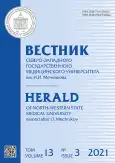Disruption of endothelial glycocalyx in patients with rheumatoid arthritis
- Authors: Shimanski D.A.1, Nesterovich I.I.1, Inamova O.V.2, Trophimov V.I.1, Galkina O.V.1, Levykina E.N.1, Vlasov T.D.1
-
Affiliations:
- First Pavlov State Medical University of Saint Petersburg
- Clinical Rheumatology Hospital No. 25
- Issue: Vol 13, No 3 (2021)
- Pages: 69-74
- Section: Original study article
- URL: https://journals.rcsi.science/vszgmu/article/view/81488
- DOI: https://doi.org/10.17816/mechnikov81488
- ID: 81488
Cite item
Abstract
BACKGROUND: Endothelial glycocalyx has an important role in the regulation of endothelial functioning. It is the first to be damaged during the development of autoimmune inflammatory diseases. Thinning of endothelial glycocalyx leads to a violation of the barrier function of blood vessels, the development and maintenance of the inflammatory process. In this context, using endothelial glycocalyx assessment for diagnostic and monitoring of diseases is considered of great interest.
AIM: To establish the relationship between endothelial glycocalyx thickness with activity, serological profile and risk factors for an unfavorable course of rheumatoid arthritis.
MATERIALS AND METHODS: The study included 76 patients from 18 to 65 years of both sexes with rheumatoid arthritis. The perfusion boundary region of endothelial glycocalyx determined using a dark-field microscope has been used as the main indicator for assessing the state of endothelial glycocalyx.
RESULTS: The obtained results have demonstrated a decrease in the initial endothelial glycocalyx thickness in females in the presence of risk factors for an unfavorable course of rheumatoid arthritis. At the same time, no relationship with the serological profile and endothelial glycocalyx thickness has been found. An inverse correlation between endothelial glycocalyx thickness and syndecan-1 level and erythrocyte sedimentation rate has been found. This confirms the fact that endothelial glycocalyxes are involved in the inflammatory process in rheumatoid arthritis. Endothelial glycocalyx assessment using dark-field microscopy made it possible to predict the subsequent appointment of pulse therapy with methylprednisolone in the hospital. On re-examination, endothelial glycocalyx thinning has been observed in the presence of unfavorable risk factors for the course of rheumatoid arthritis, in negative to anti-cyclic citrullinated peptide antibodies patients, or in the absence of response to treatment.
CONCLUSIONS: The use of dark-field microscopy is unique in its capabilities for intravital and non-invasive assessment of endothelial glycocalyx thickness. It provides important fundamental information deepening knowledge in the pathological physiology of disease. From a clinical point of view, it allows to consider a decrease in endothelial glycocalyx thickness as an additional prognostically unfavorable marker in rheumatoid arthritis.
Full Text
##article.viewOnOriginalSite##About the authors
Daniel A. Shimanski
First Pavlov State Medical University of Saint Petersburg
Author for correspondence.
Email: shimanskidaniel@gmail.com
ORCID iD: 0000-0002-6903-2217
SPIN-code: 2022-5223
ResearcherId: AAW-1441-2020
post-graduate student of the Department
of Hospital Therapy with a course of Allergology and Immunology named after acad. M. V. Chernorutsky with a clinic
Irina I. Nesterovich
First Pavlov State Medical University of Saint Petersburg
Email: nester788@gmail.com
SPIN-code: 8921-1751
MD, Dr. Sci. (Med.)
Russian Federation, 6/8 Lva Tolstogo St., Saint Petersburg, 197022Oksana V. Inamova
Clinical Rheumatology Hospital No. 25
Email: b25@zdrav.spb.ru
ORCID iD: 0000-0001-9126-3639
SPIN-code: 8841-5496
MD, Cand. Sci. (Med.)
Russian Federation, Saint PetersburgVasilii I. Trophimov
First Pavlov State Medical University of Saint Petersburg
Email: trofvi@mail.ru
SPIN-code: 1306-5645
MD, Dr. Sci. (Med.), Professor
Russian Federation, 6/8 Lva Tolstogo St., Saint Petersburg, 197022Olga V. Galkina
First Pavlov State Medical University of Saint Petersburg
Email: nephrolog1985@gmail.com
ORCID iD: 0000-0001-7265-7392
SPIN-code: 4251-6056
Cand. Sci. (Biol.), Assistant Professor
Russian Federation, 6/8 Lva Tolstogo St., Saint Petersburg, 197022Elena N. Levykina
First Pavlov State Medical University of Saint Petersburg
Email: nephrolog1985@gmail.com
ORCID iD: 0000-0001-8024-2904
SPIN-code: 9550-6270
a researcher of biochemical homeostasis laboratory of Nephrology Research Institute
Russian Federation, 6/8 Lva Tolstogo St., Saint Petersburg, 197022Timur D. Vlasov
First Pavlov State Medical University of Saint Petersburg
Email: tvlasov@yandex.ru
ORCID iD: 0000-0002-6951-7599
SPIN-code: 8367-1246
MD, Dr. Sci. (Med.), Professor
Russian Federation, 6/8 Lva Tolstogo St., Saint Petersburg, 197022References
- Aletaha D, Neogi T, Silman AJ, et al. 2010 Rheumatoid arthritis classification criteria: an American College of Rheumatology/European League Against Rheumatism collaborative initiative. Arthritis Rheum. 2010;62(9):2569–2581. doi: 10.1002/art.27584
- Cao RN, Tang L, Xia ZY, Xia R. Endothelial glycocalyx as a potential theriapeutic target in organ injuries. Chin Med J (Engl). 2019;132(8):963–975. doi: 10.1097/CM9.0000000000000177
- Lee DH, Dane MJ, van den Berg BM, et al. Deeper penetration of erythrocytes into the endothelial glycocalyx is associated with impaired microvascular perfusion. PLoS One. 2014;9(5):e96477. doi: 10.1371/journal.pone.0096477
- McDonald KK, Cooper S, Danielzak L, Leask RL. Glycocalyx degradation induces a proinflammatory phenotype and increased leukocyte adhesion in cultured endothelial cells under flow. PLoS One. 2016;11(12):e0167576. doi: 10.1371/journal.pone.0167576
- Eickhoff MK, Winther SA, Hansen TW, et al. Assessment of the sublingual microcirculation with the GlycoCheck system: Reproducibility and examination conditions. PLoS One. 2020;15(12):e0243737. doi: 10.1371/journal.pone.0243737
- Vlasov TD, Lazovskaya OA, Shimanski DA, et al. The endothelial glycocalyx: research methods and prospects for their use in endothelial dysfunction assessment. Regional Hemodynamics and Microcirculation. 2020;19(1(73)):5–16. (In Russ.). doi: 10.24884/1682-6655-2020-19-1-5-16
- Mel’nikova YuS, Makarova TP. Endothelial dysfunction as the key link of chronic diseases pathogenesis. Kazan medical journal. 2015;96(4):659–665. (In Russ.). doi: 10.17750/KMJ2015-659
Supplementary files










